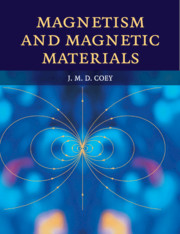Book contents
- Frontmatter
- Contents
- List of tables of numerical data
- Preface
- Acknowledgements
- 1 Introduction
- 2 Magnetostatics
- 3 Magnetism of electrons
- 4 Magnetism of localized electrons on the atom
- 5 Ferromagnetism and exchange
- 6 Antiferromagnetism and other magnetic order
- 7 Micromagnetism, domains and hysteresis
- 8 Nanoscale magnetism
- 9 Magnetic resonance
- 10 Experimental methods
- 11 Magnetic materials
- 12 Applications of soft magnets
- 13 Applications of hard magnets
- 14 Spin electronics and magnetic recording
- 15 Special topics
- Appendices
- Formula index
- Index
- Tables, conversions, constants and units
5 - Ferromagnetism and exchange
Published online by Cambridge University Press: 05 June 2012
- Frontmatter
- Contents
- List of tables of numerical data
- Preface
- Acknowledgements
- 1 Introduction
- 2 Magnetostatics
- 3 Magnetism of electrons
- 4 Magnetism of localized electrons on the atom
- 5 Ferromagnetism and exchange
- 6 Antiferromagnetism and other magnetic order
- 7 Micromagnetism, domains and hysteresis
- 8 Nanoscale magnetism
- 9 Magnetic resonance
- 10 Experimental methods
- 11 Magnetic materials
- 12 Applications of soft magnets
- 13 Applications of hard magnets
- 14 Spin electronics and magnetic recording
- 15 Special topics
- Appendices
- Formula index
- Index
- Tables, conversions, constants and units
Summary
Order, order, order!
Ferromagnetism and the Curie temperature were explained by Weiss in terms of a huge internal ‘molecular field’ proportional to the magnetization. The theory is applicable both to localized and delocalized electrons. No such magnetic field really exists, but it is a useful way of approximating the effect of the interatomic Coulomb interaction in quantum mechanics, which Heisenberg described by the Hamiltonian ℋ = −2JS1 · S2, where S1 and S2 are operators describing the localized spins on two adjacent atoms. When J > 0, ferromagnetic exchange leads to ferromagnetic order in three dimensions. Spin waves are the low-energy excitations of the exchange-coupled magnetic lattice. In the delocalized electron picture, a ferromagnet has spontaneously spin-split energy bands. The density of ↑ and ↓ states is calculated using spin-dependent density functional theory. Important physical phenomena associated with ferromagnetism are discussed in this chapter, including magnetic anisotropy and, magnetoelastic, magneto-optic and magnetotransport effects.
The characteristic feature of a ferromagnet is its spontaneous magnetization Ms, which is due to alignment of the magnetic moments located on an atomic lattice. The magnetization tends to lie along easy directions determined by crystal structure, atomic-scale texture or sample shape. Heating above a critical temperature known as the Curie point, which ranges from less than 1 K for magnetically dilute salts to almost 1400 K for cobalt, leads to a reversible collapse of the spontaneous magnetization.
- Type
- Chapter
- Information
- Magnetism and Magnetic Materials , pp. 128 - 194Publisher: Cambridge University PressPrint publication year: 2010
- 1
- Cited by

